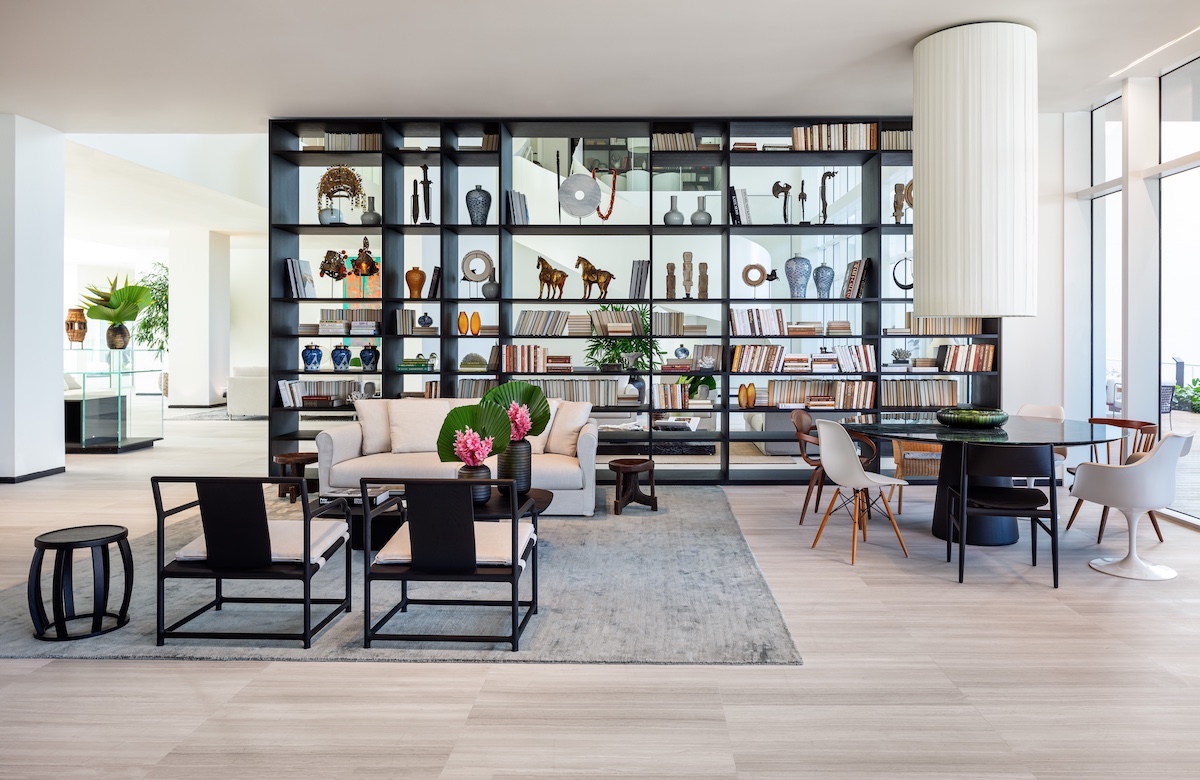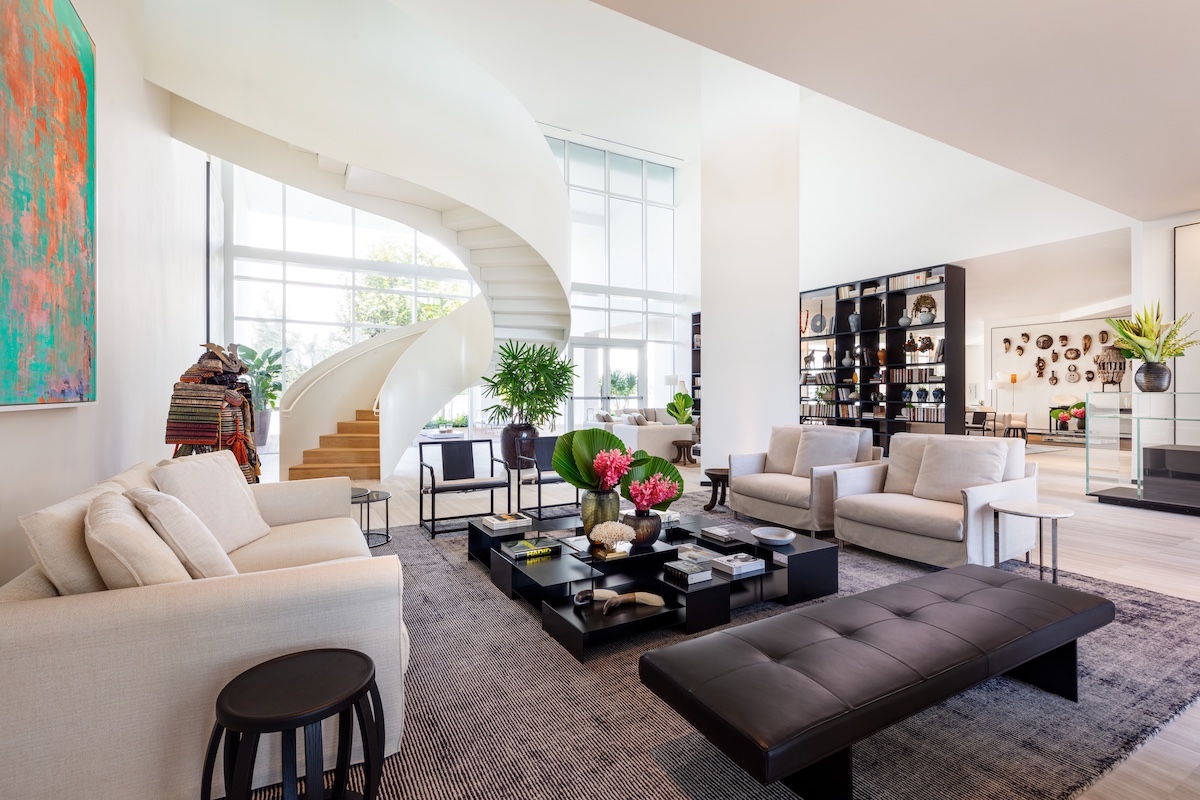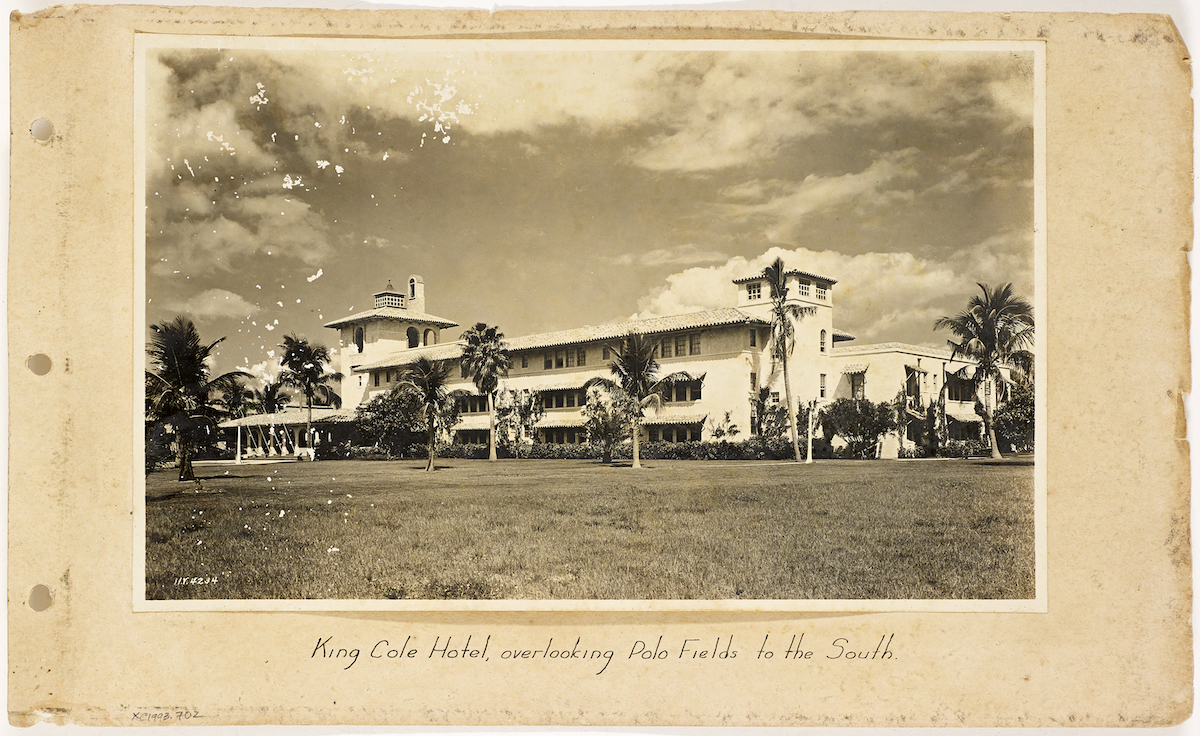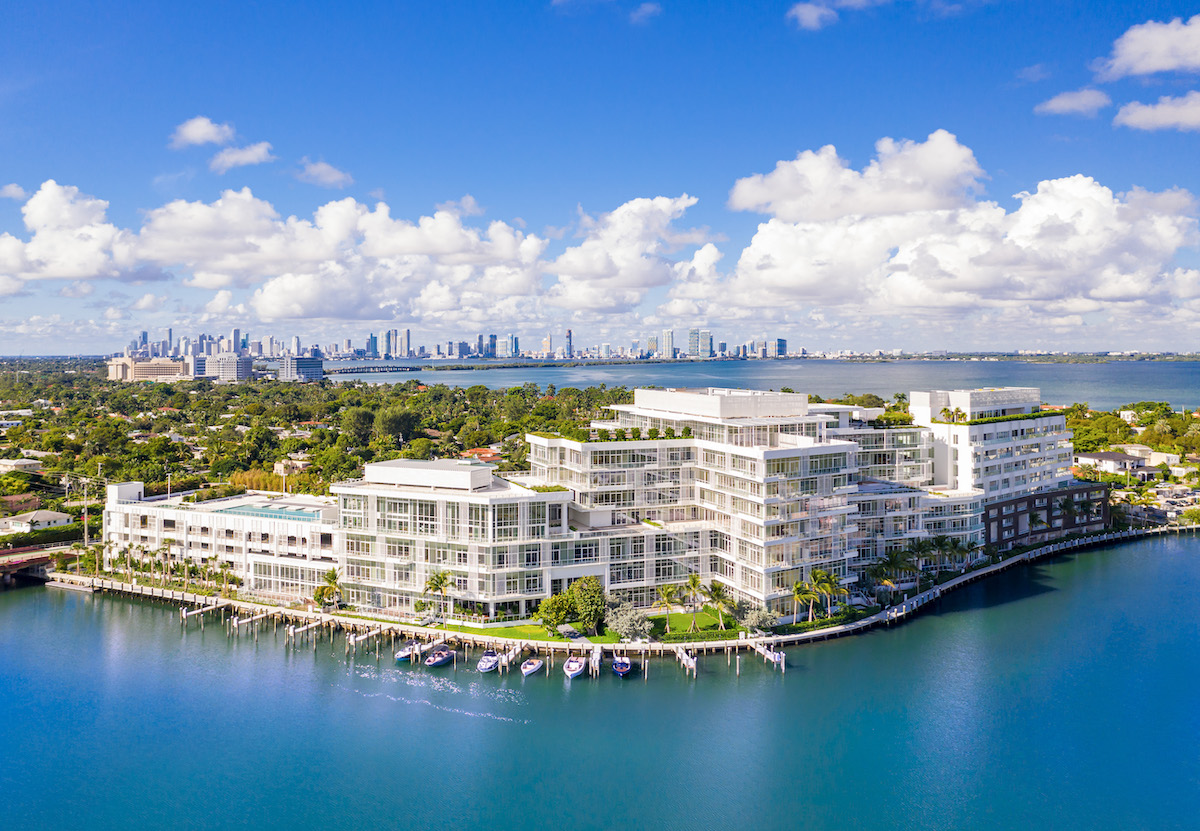In the 1920s, the King Cole Hotel helped put Miami Beach on the map as a popular tourist destination. Automotive industry pioneer and entrepreneur Carl Fisher developed the three-story, 60-room hotel to fulfill his vision of turning vacant land into an oceanfront winter getaway.
The hotel, which functioned as a military hospital during World War II, faced the wrecking ball in 1965 to make way for the property’s next occupant: the Miami Heart Institute. Over the next three decades, the hospital expanded its footprint on the 7.2-acre site to encompass six structures.
In 2000, Mount Sinai Medical Center acquired the Miami Heart Institute and ultimately consolidated its operations at the competing hospital system’s main campus about a mile away.
Real estate investment and development firm Lionheart Capital stepped in to purchase the deserted complex for $20 million in 2012, initiating the property’s third act as a luxury condo development. “It was a fair price, in an excellent location, and we felt confident we could transform the property into something truly special,” said Allison Greenfield, Partner at Lionheart Capital.

Residents have 24-hour access to a private art studio equipped with easels, sculpting surfaces, reference books, and supplies. Photo: Kim Sargent
But Lionheart faced some tough obstacles in converting the former hospital into condos—and starting from scratch wasn’t an option. “The site was overbuilt by about 600,000 square feet, so we would lose that space if we demolished the buildings,” said Greenfield. Rezoning the property to residential use would also limit the maximum building height of new construction to four stories.
Lionheart enlisted Stantec’s Miami practice to oversee the conversion process as architect of record. “The city was eager to approve the zoning change as long as the neighbors were in favor of it,” said Christina Villa, Senior Associate in Stantec’s Miami office.
ALSO SEE: Historic ‘skyscraper hospital’ in Brooklyn refashioned into 17 luxury condominium residences
Stantec staff met with residents of the surrounding Mid-Beach neighborhood, composed of single-family homes that range from historic 1920s structures to modern residences. “Most of the neighbors were ecstatic to hear that we were planning a condo development because it would decrease traffic and be more compatible with the neighborhood,” said Villa.
The intricate planning and design process involved reconfiguring the existing institutional building layouts to accommodate high-end residential units. “We stripped away everything that made the complex look like a hospital and brought it down to its bare columns, then started to carve out the massing of the buildings to make the floor plates work,” said Villa.
The process yielded a staggering 64 different unit layouts. “Unlike a typical South Florida multifamily building, where buyers choose a view and a stock layout, we essentially created 64 vertically stacked single-family homes,” said Greenfield.

The club room at the Ritz-Carlton Residences. Residents have access to the services of the Agatston Center for Private Medicine, led by Arthur Agatston, the cardiologist who created the South Beach Diet. Photo: Kim Sargent
Because the slabs between adjoining buildings did not align, the Stantec team planned each unit within the floor plates of its original structure, then created several new elevator lobbies that would transport residents directly up to their units.
The lower levels of the former hospital featured floor-to-floor heights of 12 to 14 feet, providing opportunities to create one-of-a-kind living spaces. “The price point for those lower floors is much higher than you would typically find in a condo tower because the units are so spectacular,” said Greenfield.
Miami's Ritz-Carlton Residences feature EUROPEAN ELEGANCE, MODERNIST AESTHETIC
To achieve its goals of establishing a European modernist design aesthetic, Lionheart engaged Italian architect and industrial designer Piero Lissoni as design architect. It was the first large-scale building project in the U.S. for the founder of Lissoni & Partners, an architecture and design studio with offices in Milan and New York.
Likening the property to “a new, small Portofino town,” Lissoni focused his attention on the building forms, façades, and public spaces. He also collaborated with Italian product designer Boffi to custom design the European-style kitchens and bathrooms in each unit.
When visitors enter the double-height main lobby, they have no clue they’re stepping into an environment that formerly housed an emergency department and surgical suites. Instead, they’re likely to be awed by the ironclad floating spiral staircase that anchors the space and the floor-to-ceiling glass wall that accentuates views of the adjacent private lake.

A floating spiral staircase marks the double-height main lobby, designed by architect Piero Lissoni, whose goal was to create the effect of a small fishing village in his native Italy. Photo: Kim Sargent
GUEST SUITES ADD A NEW OPTION TO THE MIX
The 678,000-sf Ritz-Carlton Residences, Miami Beach houses 111 condos that range in size from 2,000 sf to more than 10,000 sf and are priced from $2 million to $40 million. Also available for purchase are nine guest suites that function like hotel rooms and are positioned around an outdoor meditation garden. With the onset of COVID-19 lockdowns and work-from-home mandates, a few residents opted to convert these suites into private office environments.
Other outdoor amenity areas include a walking track that circumnavigates the property and a half-acre rooftop pool deck with private cabanas. Located atop the former hospital’s main parking structure, the expansive space offers panoramic vistas of the Atlantic Ocean, Biscayne Bay, and downtown Miami.
ALSO SEE: Designing multifamily housing for COVID-19
Residents can grow and pick their own fruits, vegetables, and herbs in the ecological food forest and community garden. They can even take advantage of a medical concierge service offered by the Agatston Center for Private Medicine, led by cardiologist Arthur Agatston, creator of the South Beach Diet.
A 36-slip private marina and captained day yacht on the neighboring Surprise Lake further distinguish the property from the region’s many other condo developments. Phase two, currently under construction, will add 15 single-family custom villas.
Since opening in February, the development is nearly sold out and has attracted an uncharacteristically large number of Florida-based residents. “I think it appeals to local buyers who may be leaving their house, but still want to maintain the individuality and specialness of their home environment,” said Greenfield. “The site is located in a beautiful, bucolic neighborhood that is perfect for those who really enjoy the South Florida lifestyle, and not just the weather.”

A postcard of the King Cole Hotel, built in 1920 by automotive industrialist Carl Fisher. The hotel was later converted to a hospital before being transitioned into residential use. Photo courtesy Stantec
PROJECT TEAM | THE RITZ-CARLTON RESIDENCES, MIAMI
DEVELOPER Lionheart Capital
DESIGN ARCHITECT | INTERIOR DESIGNER Lissoni & Partners
ARCHITECT OF RECORD Stantec
STRUCTURAL ENGINEER McNamara Salvia
CIVIL ENGINEER Kimley Horn
MEP ENGINEER Steven Feller, PE
BUILDING ENVELOPE CONSULTANT Paramount Consulting and Engineering
LANDSCAPE ARCHITECT Rhett Roy Landscape Architecture Planning
GENERAL CONTRACTOR Plaza Construction
Related Stories
| Dec 17, 2010
Toronto church converted for condos and shopping
Reserve Properties is transforming a 20th-century church into Bellefair Kew Beach Residences, a residential/retail complex in The Beach neighborhood of Toronto. Local architecture firm RAWdesign adapted the late Gothic-style church into a five-story condominium with 23 one- and two-bedroom units, including two-story penthouse suites. Six three-story townhouses also will be incorporated. The project will afford residents views of nearby Kew Gardens and Lake Ontario. One façade of the church was updated for retail shops.
| Dec 7, 2010
Prospects for multifamily sector improve greatly
The multifamily sector is showing signs of a real recovery, with nearly 22,000 new apartment units delivered to the market. Net absorption in the third quarter surged by 94,000 units, dropping the national vacancy rate from 7.8% to 7.1%, one of the largest quarterly drops on record, and rents increased for the second quarter in a row.
| Nov 3, 2010
Senior housing will be affordable, sustainable
Horizons at Morgan Hill, a 49-unit affordable senior housing community in Morgan Hill, Calif., was designed by KTGY Group and developed by Urban Housing Communities. The $21.2 million, three-story building will offer 36 one-bed/bath units (773 sf) and 13 two-bed/bath units (1,025 sf) on a 2.6-acre site.
| Nov 3, 2010
Rotating atriums give Riyadh’s first Hilton an unusual twist
Goettsch Partners, in collaboration with Omrania & Associates (architect of record) and David Wrenn Interiors (interior designer), is serving as design architect for the five-star, 900-key Hilton Riyadh.
| Nov 1, 2010
Sustainable, mixed-income housing to revitalize community
The $41 million Arlington Grove mixed-use development in St. Louis is viewed as a major step in revitalizing the community. Developed by McCormack Baron Salazar with KAI Design & Build (architect, MEP, GC), the project will add 112 new and renovated mixed-income rental units (market rate, low-income, and public housing) totaling 162,000 sf, plus 5,000 sf of commercial/retail space.
| Nov 1, 2010
Vancouver’s former Olympic Village shoots for Gold
The first tenants of the Millennium Water development in Vancouver, B.C., were Olympic athletes competing in the 2010 Winter Games. Now the former Olympic Village, located on a 17-acre brownfield site, is being transformed into a residential neighborhood targeting LEED ND Gold. The buildings are expected to consume 30-70% less energy than comparable structures.
| Oct 13, 2010
Apartment complex will offer affordable green housing
Urban Housing Communities, KTGY Group, and the City of Big Bear Lake (Calif.) Improvement Agency are collaborating on The Crossings at Big Bear Lake, the first apartment complex in the city to offer residents affordable, eco-friendly homes. KTGY designed 28 two-bedroom, two-story townhomes and 14 three-bedroom, single-story flats, averaging 1,100 sf each.
| Oct 13, 2010
Residences bring students, faculty together in the Middle East
A new residence complex is in design for United Arab Emirates University in Al Ain, UAE, near Abu Dhabi. Plans for the 120-acre mixed-use development include 710 clustered townhomes and apartments for students and faculty and common areas for community activities.
| Oct 13, 2010
Community center under way in NYC seeks LEED Platinum
A curving, 550-foot-long glass arcade dubbed the “Wall of Light” is the standout architectural and sustainable feature of the Battery Park City Community Center, a 60,000-sf complex located in a two-tower residential Lower Manhattan complex. Hanrahan Meyers Architects designed the glass arcade to act as a passive energy system, bringing natural light into all interior spaces.
| Oct 12, 2010
The Watch Factory, Waltham, Mass.
27th Annual Reconstruction Awards — Gold Award. When the Boston Watch Company opened its factory in 1854 on the banks of the Charles River in Waltham, Mass., the area was far enough away from the dust, dirt, and grime of Boston to safely assemble delicate watch parts.
















